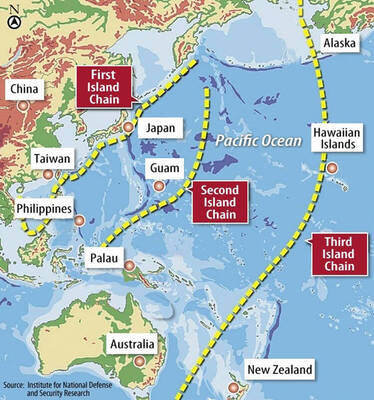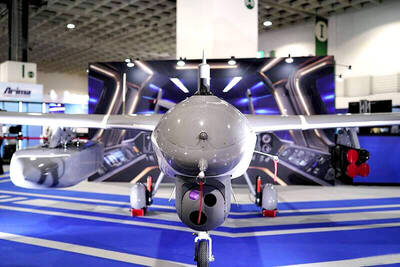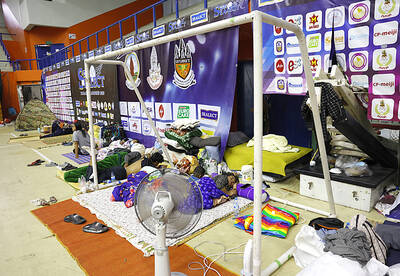In a military switch with direct implications for Taiwan, the Pentagon is changing the way it spies on China.
US General Gary North, Pacific Air Forces Commander, has announced that three Global Hawk drones — the US’ most advanced unmanned planes — are to be based at Anderson Air Force Base in Guam.
They are expected to start operating from Guam as soon as tomorrow.
North confirmed that the drones would gather intelligence and conduct surveillance and reconnaissance.
The Global Hawks will eventually take over completely from the U-2 spy planes and the RC-135 surveillance aircraft in the Asia-Pacific region.
These are the manned aircraft that currently fly high over the Taiwan Strait at regular intervals to monitor China’s missile buildup and the military forces facing Taiwan.
The spy planes — and now the drones — would probably provide the first major clues if China began moving towards an attack or invasion.
“The move to drones is definitely something for Taiwan to take note of. It’s a significant development,” said John Pike, head of the Washington-based think tank Global Security.
He said that it signaled Washington’s continued commitment to gathering intelligence in the region following the retirement of the U-2s and the RC-135s.
While it will take some months to establish that the drones can do as good a job as the manned spy planes, analysts believe they will provide a comparable service over the Taiwan Strait.
The drones do not fly as high as the spy planes, but will cover Chinese missile fields and bases in all of the coastal areas facing Taiwan.
Global Hawks can reach altitudes of 19km — well above the range of most defensive weapons — and can stay in the air for more than 32 hours at a time.
“It flies for more than a day and it flies at very good speeds and so you could transit a long distance,” North said.
While the exact figures are classified, it is believed that Global Hawks can fly about 16,000km on one mission.
The first of the three drones to be stationed on Guam arrived there earlier this month following an 18-hour journey from Beale Air Force Base in California.
Officially known as the RQ-4 Global Hawk, the drones are made by Northrop Grumman and cost about US$183 million each.
The drones have been described as having a “bulbous, whale-shaped nose” and have a top-mounted engine and V-tail. They are 13m long with a wingspan of 35m. Using information gathered by the spy plane program, the Pentagon reported this summer that China now has more than 1,400 missiles aimed at Taiwan and that despite much warmer economic relations “there have been no meaningful actions on the part of the mainland to reduce its military presence opposite the island.”
The Pentagon has concluded that with China’s rapidly expanding arsenal of ships, missiles and aircraft the cross-strait military balance continues to “shift in the mainland’s favor.”
With this in mind, US Representative Edward Royce told the US House of Representatives this week: “To help close the gap, Taiwan has had a pending request to buy additional F-16 fighter jets. The [US President Barack] Obama administration is still ‘studying’ this proposal.”
“Taiwan faces one of the most complex and lethal military threats in the world. Across the region, in response to China’s buildup and increasing assertiveness, China’s neighbors are moving to strengthen their security relationships with the US,” he said.
“This gravitation to the US will only last as long as the US is seen as a credible guarantor of stability. Moving forward with this F-16 sale would be an appropriate signal to Taiwan and the region. If we want cross-strait detente to succeed, Taiwan will have to operate from a position of strength,” Royce said.

The US government has signed defense cooperation agreements with Japan and the Philippines to boost the deterrence capabilities of countries in the first island chain, a report by the National Security Bureau (NSB) showed. The main countries on the first island chain include the two nations and Taiwan. The bureau is to present the report at a meeting of the legislature’s Foreign Affairs and National Defense Committee tomorrow. The US military has deployed Typhon missile systems to Japan’s Yamaguchi Prefecture and Zambales province in the Philippines during their joint military exercises. It has also installed NMESIS anti-ship systems in Japan’s Okinawa

‘WIN-WIN’: The Philippines, and central and eastern European countries are important potential drone cooperation partners, Minister of Foreign Affairs Lin Chia-lung said Minister of Foreign Affairs Lin Chia-lung (林佳龍) in an interview published yesterday confirmed that there are joint ventures between Taiwan and Poland in the drone industry. Lin made the remark in an exclusive interview with the Chinese-language Liberty Times (the Taipei Times’ sister paper). The government-backed Taiwan Excellence Drone International Business Opportunities Alliance and the Polish Chamber of Unmanned Systems on Wednesday last week signed a memorandum of understanding in Poland to develop a “non-China” supply chain for drones and work together on key technologies. Asked if Taiwan prioritized Poland among central and eastern European countries in drone collaboration, Lin

Renewed border fighting between Thailand and Cambodia showed no signs of abating yesterday, leaving hundreds of thousands of displaced people in both countries living in strained conditions as more flooded into temporary shelters. Reporters on the Thai side of the border heard sounds of outgoing, indirect fire yesterday. About 400,000 people have been evacuated from affected areas in Thailand and about 700 schools closed while fighting was ongoing in four border provinces, said Thai Rear Admiral Surasant Kongsiri, a spokesman for the military. Cambodia evacuated more than 127,000 villagers and closed hundreds of schools, the Thai Ministry of Defense said. Thailand’s military announced that

NO CONFIDENCE MOTION? The premier said that being toppled by the legislature for defending the Constitution would be a democratic badge of honor for him Premier Cho Jung-tai (卓榮泰) yesterday announced that the Cabinet would not countersign the amendments to the local revenue-sharing law passed by the Legislative Yuan last month. Cho said the decision not to countersign the amendments to the Act Governing the Allocation of Government Revenues and Expenditures (財政收支劃分法) was made in accordance with the Constitution. “The decision aims to safeguard our Constitution,” he said. The Constitution stipulates the president shall, in accordance with law, promulgate laws and issue mandates with the countersignature of the head of the Executive Yuan, or with the countersignatures of both the head of the Executive Yuan and ministers or